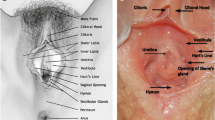Abstract
Background
Vulvovaginitis is the most common cause of gynecological complaints in children and young girls. Some of the factors which cause vulvovaginitis include hypoestrogenism, the anatomical proximity of rectum and delicate vulvar skin and vaginal mucosa.
Data sources
We made a literature search with Pubmed, Medline and Cochrane database from January 2002 to May 2015 in English language using the key words vulvovaginitis, children, clinical, diagnosis and treatment.
Results
Vulvovaginitis in girls is usually caused by non-specific factors and hygiene measures, bioyoghurt and avoidance of chemical irritants are generally useful. Weight control if necessary and prevention of voiding dysfunction are effective. Vaginal flora is important in girls and results should be interpreted with clinical features to decide whether an isolated microorganism is part of the normal microflora or is the cause of symptomatic vulvovaginitis. Specific treatment is generally considered in case of a detected pathogen microorganism. Isolation of a sexually transmitted organism requires further investigation. Persistent disease may not always indicate a foreign body but it must be taken into account. Girls and parents are encouraged psychologically in all steps of evaluation, diagnosis and treatment. Probiotics, nanotechnology and petroleum jelly are other important treatment options used in vulvovaginitis.
Conclusions
In this review, we present current approach to the presentation and management of vulvovaginitis in childhood. This disorder requires a comprehensive evaluation in all steps of diagnosis, differential diagnosis and treatment.
Similar content being viewed by others
References
Joishy M, Ashtekar CS, Jain A, Gonsalves R. Do we need to treat vulvovaginitis in prepubertal girls? BMJ 2005;330:186–188.
Rome ES. Vulvovaginitis and other common vulvar disorders in children. Endocr Dev 2012;22:72–83.
Giugno S, Risso P, Ocampo D, Rahman G, Rubinstein DA. Vulvovaginitis in a pediatric population: relationship among etiologic agents, age and Tanner staging of breast development. Arch Argent Pediatr 2014;112:65–74.
Romero P, Rodriguez E, Munoz M, Delucchi A, Guerrero JL, Lillo AM, et al. Voiding dysfunction: another etiology of vulvovaginitis in young girls. J Pediatr Adolesc Gynecol 2011;24:189–191.
Curran J, Hayward J, Sellers E, Dean H. Severe vulvovaginitis as a presenting problem of type 2 diabetes in adolescent girls, a case series. Pediatrics 2011;127:1081–1085.
Stricker T, Navratil F, Sennhauser FH. Vulvovaginitis in prepubertal girls. Arch Dis Child 2003;88:324–326.
Gorbachinsky I, Sherertz R, Russell G, Krane L, Hodges S. Altered perineal microbiome is associated with vulvovaginitis and urinary tract infection in preadolescent girls. Ther Adv Urology 2014;6:224–229.
Yilmaz A, Celik N, Soylu G, Donmez A, Yuksel C. Comparison of clinical and microbiological features of vulvovaginitis in prepubertal and pubertal girls. J Formos Med Assoc 2012;111:392–396.
Randelovic G, Mladenovic V, Ristic L, Otasevic S, Brankovic S, Mladenovic SA, et al. Microbiological aspects of vulvovaginitis in prepubertal girls. Eur J Pediatr 2012;171:1203–1208.
Van Neer PA, Korver CR. Constipation presenting as recurrent vulvovaginitis in prepubertal children. J Am Acad Dermatol 2000;43:718–719.
Smith YR, Berman DR, Quint EH. Premenarcheal vaginal discharge, findings of procedures to rule out foreign bodies. J Pediatr Adolesc Gynecol 2002;13:227–230.
Thomas A, Forster G, Robinson A, Rogstad K; Clinical Effectiveness Group (Association of Genitourinary Medicine and the Medical Society for the Study of Venereal Diseases). National guideline for the management of suspected sexually transmitted infections in children and young people. Sex Transm Infect 2002;78:324–331.
Eyk NV, Allen L, Giesbrecht E, Jamieson MA, Kives S, Morris M, et al. Pediatric vulvovaginal disorders: a diagnostic approach and review of the literature. J Obstet Gynaecol Can 2009;31:850–862.
Merritt DF. Gynecologic problems of childhood, Vulvovaginitis. In: Kliegmen RM, Stanton BF, Geme JW, Schor NF, Behrman RE, eds. Nelson Textbook of Pediatrics, 19th edn. Philadelphia: Elsevier Saunders, 2011:1865–1869.
Anderson B, Thimmesch I, Aardsma N, Ed MT, Carstater S, Schober J. The prevalence of abnormal genital findings, vulvovaginitis, enuresis and encopresis in children who present with allegations of sexual abuse. J Pediatr Urol 2014;10:1216–1221.
Ram AD, Hurst KV, Steinbrecher H. The role of cystovaginoscopy and hygienic advice in girls referred for symptoms of vulvovaginitis. Arch Dis Child 2012;97:477.
Tartaglia E, Giugliano B, Ucciferri C, Giannattasio A, Giuliano P, Iannaccone VL. Vulvovaginitis in prepubertal girls: new way of administering old drugs. J Pediatr Adolesc Gynecol 2013;26:277–280.
Zhang J, Deng J, Wang Z, Che C, Li YF, Yang Q. Modulatory effects of Lactobacillus salivarius on intestinal mucosal immunity of piglets. Curr Microbiol 2011;62:1623–1631.
Akil I, Yilmaz O, Kurutepe S, Degerli K, Kavukcu S. Influence of oral intake of Saccharomyces boulardii on Escherichia coli in enteric flora. Pediatric Nephrol 2006;21:807–810.
Knetsch ML, Koole H. New strategies in the development of antimicrobial coatings: the example of increasing usage of silver and silver nanoparticles. Polymers 2011;3:340–366.
He W, Wang D, Ye Z, Qian W, Tao Y, Shi X, et al. Application of a nanotechnology antimicrobial spray to prevent lower urinary tract infection: a multicenter urology trial. J Transl Med 2012;10:S14.
Trautner BW, Lopez AI, Kumar A, Siddiq DM, Liao KS, Li Y, et al. Nanoscale surface modification favors benign biofilm formation and impedes adherence by pathogens. Nanomedicine 2012;8:261–270.
Kavukcu S, Camlar SA, Soylu A. Can nanotechnology antimicrobial underpant prevent bacterial contamination in bag urine samples: results of a preliminary study. 48th ESPN Annual Scientific Meeting of the European Society for Pediatric Nephrology. 2015 September 3-5, Brussels. Pediatr Nephrol 2015;30:59.
Bacon JL. Prepubertal labial adhesions: evaluation of a referral population. Am J Obstet Gynecol 2002;187:327–333.
Author information
Authors and Affiliations
Corresponding author
Rights and permissions
About this article
Cite this article
Beyitler, İ., Kavukcu, S. Clinical presentation, diagnosis and treatment of vulvovaginitis in girls: a current approach and review of the literature. World J Pediatr 13, 101–105 (2017). https://doi.org/10.1007/s12519-016-0078-y
Received:
Accepted:
Published:
Issue Date:
DOI: https://doi.org/10.1007/s12519-016-0078-y




